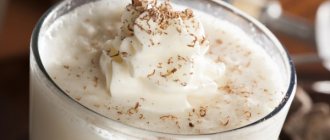It was very difficult for me to give up milk. Both physically and psychologically. I have always liked its taste, and a glass of milk with a piece of bread is the simplest and most favorite food since childhood. Not to mention what we have been taught since childhood: milk is the healthiest product in the world, a source of protein, calcium, potassium, B12 and vitamin D.
Therefore, even when I heard from experts that most adults cannot digest lactose, and casein causes a lot of ailments and serious illnesses (there are even studies that milk causes cancer), the idea of the dangers of milk was still difficult to perceive.
And yet, I gave up milk and all dairy products in one minute - at the same time I switched to a plant-based diet (read the article “What should I eat to lose weight? Victoria Davydova - about her plant-based diet”).
At first, to be honest, I thought it was temporary, and in the winter I would introduce some amount of animal proteins into my diet. But I didn't need this. And largely because I found a great alternative - vegan plant milk. It completely replaced cow milk for me.
I am often asked which milk is tastier and healthier. There is no clear answer: different types of milk have a different set of nutrients, vitamins and minerals. Moreover, even among producers, milk of the same type may differ in taste and composition.
You have to try and find what you like. In any case, be sure to check the composition on the packaging: many alternatives contain stabilizers, emulsifiers, flavorings, and often add sugar.
As for options enriched with vitamins and minerals, this is only a plus. The extra nutrients may be beneficial for some people and not harmful for everyone else.
Almond milk
The most popular non-dairy milk. And it’s better to start getting acquainted with the world of plant-based milk with almond milk, since it is the most neutral - with a subtle, mild taste, not thick, but not watery, with a slight pleasant smell. I use it instead of regular milk and water - for smoothies, sauces or dough.
Many people choose almond milk because of its low calorie content. But being low in calories doesn't automatically mean it's the healthiest choice. Low-calorie foods often contain few nutrients. It's the same story with almond milk - it has significantly less protein, fiber and even fat than almonds or other types of plant milk.
1 cup of almond milk contains:
- 30 calories
- 2.5 g fat
- 1 g carbohydrates
- 1 g fiber
- 0 g sugar
- 1 g protein
Milk exam. Why the tastiest milk is not always the best.
When planning the April “People's Expertise”, we decided not to philosophize over the choice of product and made ordinary milk the object of our research. And to find out how consumers feel about this product, we went to Logoisk. There, in the Zamkovy supermarket, one of the most visited stores in the city, a tasting was held.
One hundred percent taste
Having studied the huge assortment of dairy departments in Minsk and Logoisk stores, for tasting we chose the most popular type of milk - pasteurized, 3.2 percent fat. And we purchased five samples from different manufacturers. It should be noted that the milk from some of our famous factories, unfortunately, could not take part in the tasting, since its fat content was different from the required one: some had 3.1 percent, others 3.3 percent. It seems like a trifle, but we decided not to violate the purity of the experiment. So, we invited our public tasters to evaluate the taste of milk from the following brands: No. 1 - “Zdravushka” (JSC Borisov Dairy Plant), No. 2 - “Slavic Traditions” (SE “GMZ No. 1”), No. 3 - “Babushkino milk" (OJSC "Babushkina Krynka"), No. 4 - "Postavy Gorodok" (OJSC "Postavy Dairy Plant"), No. 5 - "Minsk Marka" (SE "GMZ No. 1"). Since this is a perishable product and the degree of its freshness can affect the taste, we purchased all the milk directly on the day of the tasting. According to the rules of the “People's Expertise,” we encrypted milk brands under serial numbers, so none of the participants knew whose milk he was drinking, and the strength and promotion of manufacturers’ brands did not affect the assessments in any way. As the tasting showed, the biggest fans of milk are children, who tried it a lot and with great eagerness. But adults, especially men, treated him with coolness. Some admitted that they did not like the taste of milk, others - that the body simply did not accept it. At first, customers at the Zamkovy supermarket were skeptical that milk could taste different. “Well, what could be different about it, there’s raw milk and maybe even cream,” some waved their hands. But tasting showed that even a product that is identical in its fat content and method of heat treatment does not taste the same. And in confirmation of this, in the very first minutes of our examination, two leaders were identified - samples No. 1 and No. 4. They were praised for their full, soft, pronounced taste, which many considered to be an indicator of the naturalness of the product. Sample No. 3 seemed to many to be sour, and No. 2 seemed “empty.” As a result of an hour and a half tasting, the milk of the Zdravushka (17 people) and Postavy Gorodok (14 votes) brands received the largest number of votes.
Is it all about fat?
According to tradition, at the second stage of the “People's Expertise”, all five samples are sent to the laboratory of the Scientific and Practical Center of the National Academy of Sciences of Belarus for Food. For experts to evaluate their quality indicators and compliance with the information stated on the label. In particular, they checked the mass fraction of fat. Despite the fact that the label on all of them stated 3.2 percent fat, in fact only “Babushkina Krynka” had such fat content. Samples No. 1, 2 and 5 contained 3.3 percent fat, and sample No. 4 contained 3.4 percent. Perhaps this is why our tasters liked the taste of this milk so much. After all, as you know, fat content improves the taste of dairy products. However, according to experts, such a minimal difference was unlikely to influence the choice. The higher the protein content in milk, the higher the quality of the raw materials and the nutritional and nutritional value of the product. According to standards, milk should contain at least 2.8 percent. All samples showed good results, but the largest amount of protein was contained in “Babushkina Krynka” - 3 percent. At the same time, sample No. 3 was criticized by some tasters for being more sour than others. Therefore, we asked our experts to check the acidity of all samples. For sample No. 3 it actually turned out to be higher - 18.5 T°. But it is unlikely that the tasters could catch it by taste and smell. In addition, according to the norms, fresh milk can have an acidity of up to 21 T°. In the laboratory, the milk was also tested for antibiotic content - there should not be any. And experts did not find antibiotics in any of the samples. “NG” verdict: all milk samples meet the requirements of the standards, and in terms of taste characteristics, consumers gave their preference to milk of the “Zdravushka” brand. And it is he who we declare the winner.
Voting results: 1. “Zdravushka” - 17 votes. 2. “Slavic traditions” - 4 voices. 3. “Grandma’s milk” - 9 votes. 4. “Postavy town” - 14 votes. 5. “Minsk Brand” - 6 votes.
Direct text
What kind of milk do you like, NG asked the residents of Logoisk
Alesya PRIMSHITS, young mother: - Milk, one might say, is my lifesaver. Soup, semolina - all this is prepared quite quickly. And most importantly, such food is healthy, especially for children. True, we often hear that children do not really like dairy dishes, especially semolina porridge. I think a child’s nutrition largely depends on the parents’ diet. If adults eat exclusively fast food and pasta, then children will get used to such food.
Vladimir AGEYCHIK, driver: — Because of my love for dairy products, friends and acquaintances jokingly call me the milkman. How can you not love milk?! I grew up in the village, and there, you understand, there is always a household. He instilled his love for milk in his children. Moreover, we buy milk with a fat content of at least 3.2-3.5 percent. Many people say it can make you gain weight. Nonsense! Real milk cannot be low in fat, and it should taste sweet. And without foreign odors.
Zoya Ivanovna, teacher: — I doubted for a long time between the fourth and first samples. Both milks are very tasty, most similar to natural milk. And yet I settled on the first one: it felt like it was a little fattier than the others. Or maybe the manufacturer added some vitamins to the first sample? By the way, when I have to buy dairy products in a store, I always pay attention to vitamin supplements. And so I try to use homemade milk.
Svetlana PETROVA with her daughter Varya: - I don’t drink milk. Probably because I remember the taste of real fresh milk. It can't be compared to store bought! Especially with powder. But my daughter, on the contrary, drinks any milk with pleasure. And from the presented samples, Varya chose the fourth: this milk is the sweetest.
Ekaterina KHOLODOK, librarian: - Low-fat milk is now very popular: 1.5 or about 2 percent. I don’t understand how you can drink it: it’s so tasteless! Yes, the price is more attractive. But I think so: why buy something you don’t like! I pay attention to the manufacturer, this makes it easier for me to navigate, because today there are many dairies. But not everyone’s milk matches my taste preferences.
Zinaida Vasilyevna, pensioner: “I am very careful when choosing all products: it is important for me that during the processing process they retain maximum of their nutritional properties. That’s why I don’t buy milk made from formula. To be honest, I’m also afraid of sterilized milk with a very long shelf life. I remember that before the milk sales period was no more than three days. Today I don’t see such dairy products. It is clear that it is beneficial for enterprises and trade to increase the shelf life: the longer it is, the greater the likelihood that the product will be purchased. But again, is there anything natural left in this milk? Questioned by Katerina ROSCHINA, “NG”
Coconut milk
There are actually two types of coconut milk. In cardboard boxes - quite watery and low-fat, with a subtle tropical taste. It can be used, like almond, for baking and smoothies.
1 cup of liquid coconut milk contains:
- 45 calories
- 4.5 g fat
- 1 g carbohydrates
- 0 g fiber
- 1 g sugar
- 0 g protein
Canned coconut milk in cans is rich and creamy, a kind of coconut cream. If you leave a can of coconut milk in the refrigerator overnight, the creamy, heavy, dense component will rise to the top, leaving “water” at the bottom.
Ideal for coffee, if you like coffee with cream, and desserts. Please note that it is very high in calories and contains saturated fat. Nutritionists advise no more than two servings per day if you are watching your weight.
1 cup of coconut cream contains:
- 420 calories
- 42 g fat
- 6 g carbohydrates
- 0 g fiber
- 3 g sugar
- 2 g protein
Soy milk
It is the best nutritional alternative to cow's milk. A cup of soy milk contains 7 grams of protein, while cow's milk contains only 1 gram more. Soy milk has a specific taste, which is not for everybody. Personally, I like it, I use it in cooking and in coffee.
And beyond taste, soy milk has a mixed reputation. In the US, a study was published several years ago that soy contains high levels of isoflavones, which can affect estrogen receptors in the body and disrupt hormone function. Later, the results of this study were revised, but the sediment, as in the joke, remained.
In addition, many people are concerned that almost all soybeans in the world are genetically modified. However, reputable medical journals state that there is no conclusive evidence that moderate amounts of soy milk can cause harm to healthy people.
1 cup of soy milk contains:
- 80 calories
- 4 g fat
- 3 g carbohydrates
- 2 g fiber
- 1 g sugar
- 7 g protein
Rice milk
Like almond milk, it is low in protein and calcium compared to cow's and soy milk, but it is low in calories. It has a sweetish taste, but is watery; for coffee, in my opinion, a more “creamy” option is needed.
The main value of rice milk is that it is the most hypoallergenic, unlike, for example, nut or soy milk.
1 cup of rice milk contains:
- 70 calories
- 2.5 g fat
- 11 g carbohydrates
- 1 g fiber
- 1 g sugar
- 0 g protein
Yogurt
Photo: Shutterstock.com
It is often recommended to use store-bought natural yogurt as a starter, but this is not entirely safe, since it may contain unaccounted for components, for example, thickeners and stabilizers. It is best to take the starter from a friend who makes homemade yogurts, or buy dry starter - it is sold in some pharmacies.
Article on the topic
The milk is excellent. What is yogurt and how is it useful?
We will need:
- Pasteurized milk with a short shelf life
- Sourdough: Bulgarian bacillus and thermophilic streptococci
- Tools: thermos or yogurt maker
Step 1. Dilute the starter with a glass of warm milk.
Step 2. Pour into a thermos and leave for 6-8 hours in a warm place.
Tip: The starter can be stored in the refrigerator for up to 2 weeks. After it is used up, you can use your own yogurt for fermentation.
Step 3. Boil milk and cool. Pour into a thermos.
Step 4. Add the starter. For 1 liter of milk - 1 tablespoon. Leave for 6 hours.
Oat milk
This type of milk is one of my favorites. Unlike, for example, almond, it does not curl, does not separate when you add it to hot coffee, and mixes well. Not to mention the natural juicy sweetness and creamy texture.
However, it contains more carbohydrates, sugar and fiber than other types of plant milk. It also contains a small amount of gluten, so it is not suitable for those with celiac disease or those on a gluten-free diet.
1 cup oat milk contains:
- 120 calories
- 5 g fat
- 16 g carbohydrates
- 2 g fiber
- 7 g sugar
- 3 g protein
Nut milk
Macadamia nuts, cashews, and hazelnuts are good sources of healthy fats, fiber, and minerals such as iron. Nuts themselves are a high-calorie product, which makes their dairy counterpart fatty and tasty, with a creamy texture.
However, this milk is quite low in calcium and protein, so choose an unsweetened, calcium-fortified option.
1 cup of nut milk contains:
- 70 calories
- 5 g fat
- 1 g carbohydrates
- 1 g fiber
- 0 g sugar
- 1 g protein
I have several types of plant milk stored at home. I drink coffee with coconut cream, add nut or oat milk to my porridge, and make cookies and pies with rice and almond milk.
WHY DO YOU NEED A MILK SEPARATOR?
| Did you know that you can make many dairy products yourself? Cream, kefir, fermented baked milk, cottage cheese, cheese, sour cream, butter, yogurt, yogurt and even ice cream - all this can be prepared at home. All you need for this is farm milk (natural milk can be bought on the market) and a household separator: Buy. |
Preparing your own dairy products has many advantages: firstly, you get a natural and tasty product, and secondly, you have complete control over the entire preparation process and can be confident in the quality of the resulting products. Homemade cream, sour cream and cottage cheese do not contain any preservatives or chemical dyes, thickeners or other additives that are harmful to the adult body and absolutely unacceptable for children.











